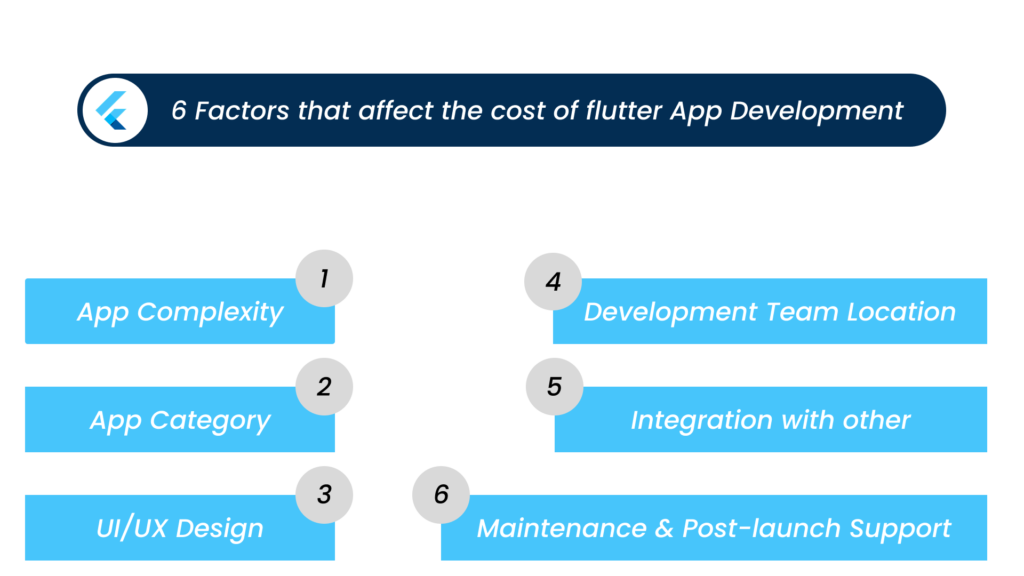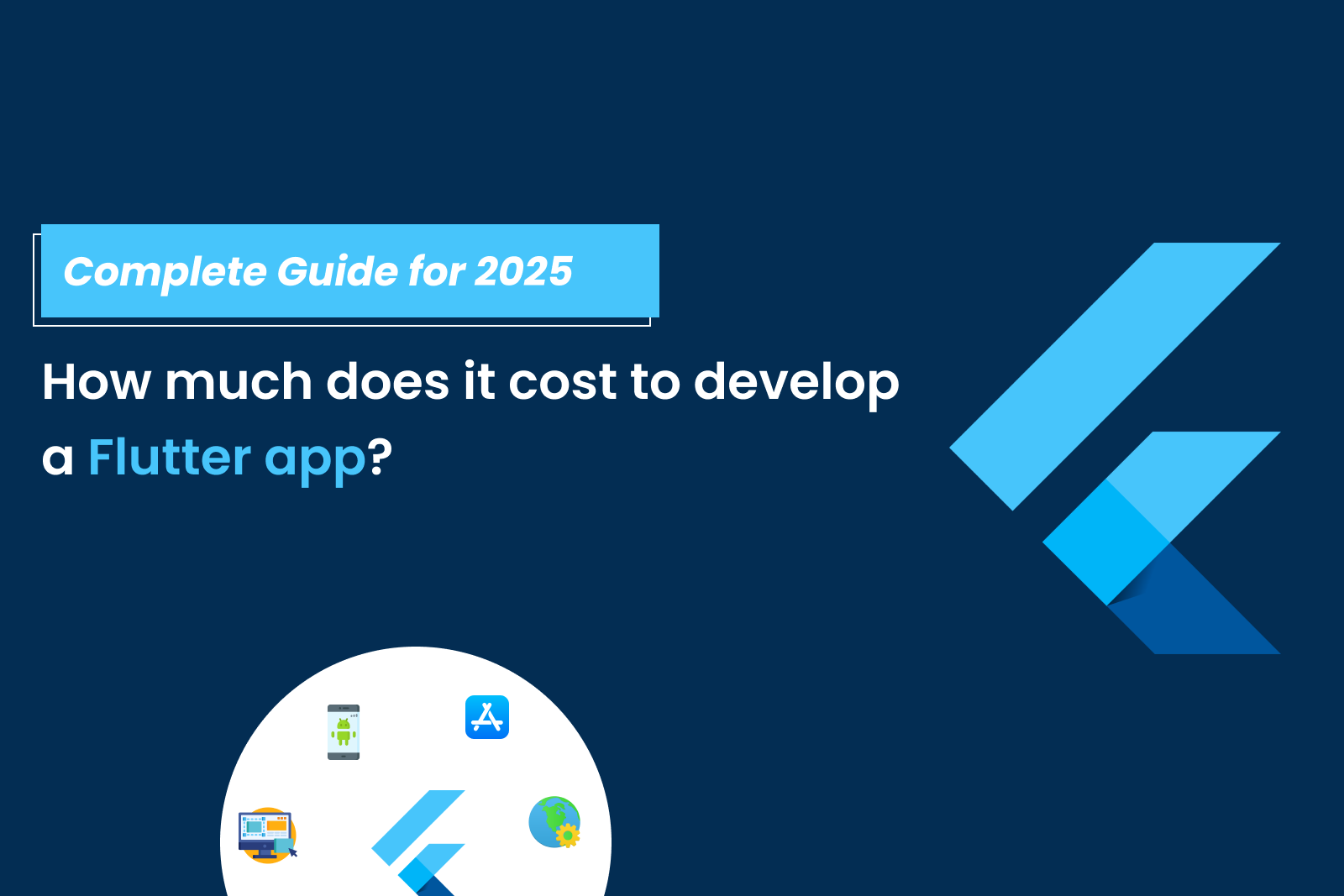As mobile-first experiences continue to dominate in 2025, Flutter app development has emerged as one of the most efficient and cost-effective solutions for building high-quality, cross-platform applications. Created by Google, Flutter allows developers to write a single codebase for both Android and iOS platforms, significantly reducing development time and costs. But just how much does Flutter app development cost in 2025? That’s exactly what we’ll explore in this complete guide.
Over the past few years, Flutter has seen exponential growth in adoption. According to a recent developer survey by Statista, Flutter is the most popular cross-platform mobile framework, used by over 46% of developers globally. Major global companies such as Google, BMW, Alibaba, eBay, Toyota, and ByteDance have adopted Flutter to build scalable, performant, and visually stunning applications. This surge in adoption is fuelled by Flutter’s robust performance, expressive UI capabilities, and growing community support.
This comprehensive guide breaks down all the key factors that influence development costs, helping you make informed decisions and avoid unexpected expenses while maximizing your return on investment.
Why choose Flutter for app development in 2025?
Choosing the right technology stack is one of the most critical decisions when building a mobile app, and in 2025, Flutter continues to stand out as a top choice for cross-platform development. Backed by Google, Flutter has rapidly evolved into a powerful SDK trusted by startups, enterprises, and developers alike. Here’s why Flutter app development remains the preferred option in 2025:
Free and Open Source
One of the biggest advantages of Flutter is that it’s completely free and open source. This means developers and businesses can use it without paying licensing fees, while also benefiting from contributions by a global community. Flutter’s transparent development model ensures continuous improvement and community-driven innovation, making it both accessible and future-ready.
One codebase for multiple platforms
Flutter allows developers to build apps for iOS, Android, web, desktop, and even embedded devices using a single codebase. This not only reduces development effort but also significantly lowers Flutter app development cost, especially for businesses targeting multiple platforms.
Faster Time to Market
Thanks to its hot reload feature and rich set of pre-built widgets, Flutter enables rapid development and real-time updates. In 2025, with rising demand for MVPs and quick app launches, Flutter helps businesses get their products to market faster than traditional native development.
Beautiful and Customizable UI
Flutter uses its own high-performance rendering engine (Skia), allowing developers to create highly customized UIs with smooth animations. It supports both Material Design (Android) and Cupertino (iOS) natively, ensuring a consistent user experience across platforms.
Cost-Effective Development
With just one development team and a unified codebase, Flutter dramatically reduces project costs. This makes it an ideal solution for startups and small businesses looking to launch robust apps without stretching their budget.
Growing Ecosystem and Community Support
As of 2025, Flutter boasts one of the most active developer communities. With thousands of plugins and packages and continuous updates from Google, the ecosystem is stronger than ever. According to GitHub metrics, Flutter has over 170K stars, making it one of the most loved frameworks in the developer community.
AI & Cloud Integration Ready
With the rise of AI-powered features and cloud-native backends, Flutter in 2025 offers seamless integration with Firebase, Google Cloud, AWS, and third-party AI services, making it a future-proof choice for innovative app development.
6 Factors that affect Flutter app development cost in 2025
Estimating the Flutter app development cost in 2025 requires a comprehensive analysis of multiple influencing factors. On average, the cost to develop a Flutter app can range from $2,500 to over $100,000, based on complexity, features, platform integration, and developer expertise. This guide provides a complete breakdown of the main cost factors to help you plan your Flutter app development budget effectively.

App Complexity
App complexity is one of the most significant determinants of your Flutter app development cost in 2025. The more features, screens, user flows, and backend logic your app requires, the more time and effort will go into its development. To make it easier to understand, app complexity is generally categorized into three levels:
| Mobile App Complexity | Includes in App | Time to Develop | Estimate the cost of an app | Example of App |
| Simple | Standard UI element MVP Functionality No third-party integration | 2-3 months | $5,000-$20,000 | Company Info App Quotes or Facts App |
| Medium Complex | Custom UI Element Third-party Integration Sophistication Features | 3-6 months | $20,000-$60,000 | Event Booking App Fitness tracker app |
| Highly Complex | Complete and Animated UI element Multiple Integration AI & ML Multi-Functional Application | 6+ Month | $60,000-$1,50,000 | AR App Advance eCommerce App |
App Category
Not all apps are built equally. Depending on what your app is intended to do—be it selling products, offering real-time communication, booking services, or delivering content—the required features, third-party integrations, data security, and performance needs will vary. These differences directly impact development time, complexity, and Flutter app cost in 2025.
Let’s break down how different app categories affect the pricing:
| App Category | Estimated Cost (USD) | Complexity Level |
| eCommerce | $10,000 – $35,000 | Medium – High |
| Social Media | $15,000 – $50,000+ | High |
| On-Demand Services | $13,000 – $45,000+ | High |
| Healthcare / Telemedicine | $18,000 – $50,000+ | High |
| EdTech / eLearning | $6,000 – $25,000 | Medium |
| FinTech / Banking Apps | $18,000 – $50,000+ | Very High |
| Media & Entertainment | $10,000 – $30,000 | Medium – High |
UI/UX Design
In Flutter app development, the User Interface (UI) and User Experience (UX) design go far beyond visual appeal—they play a critical role in improving usability, increasing user engagement, and boosting retention rates. As we move through 2025, users expect sleek, responsive, and intuitive app designs that deliver seamless performance across all devices. Opting for custom UI/UX design over standard templates can raise your Flutter app development cost, but it adds significant value by enhancing brand identity and delivering a superior user journey.
What Drives Up the Cost?
Unique Layouts
Apps that break away from conventional screen flows (e.g., TikTok’s swipe interface or Tinder’s card-based UI) require more time in wireframing, prototyping, and development.
Custom Animations & Transitions
Flutter supports advanced animations using Animation Controller, Hero, and Lottie, but implementing these can significantly increase development time and cost.
Micro interactions
Subtle interactions like button effects, loading spinners, or hover animations add to the experience but take additional effort.
Platform-Specific UX Tweaks
Although Flutter is cross-platform, some custom UI elements may need adjustment for Android vs. iOS, especially in terms of navigation, gestures, and transitions.
Responsive & Adaptive Design
Ensuring that your app looks and works great on a range of screen sizes (phones, tablets, foldables, web) increases design complexity.
User Testing & Iteration
Custom designs often go through multiple testing and feedback rounds before approval. Each iteration impacts the timeline and budget.
Development Team Location
One of the most significant factors impacting the Flutter app development cost in 2025 is the geographic location of your development team. Developer hourly rates differ widely across regions due to variations in living expenses, market demand, economic conditions, and developer availability. For instance, hiring Flutter developers in India or Eastern Europe is generally more cost-effective than in North America or Western Europe, making outsourcing Flutter development a popular strategy for reducing overall costs.
Choosing where your Flutter app is built can mean the difference between a $10,000 MVP and a $100,000+ fully scalable solution.
| Region | Hourly Rate (USD) |
| India | $15 – $35/hour |
| Eastern Europe | $25 – $60/hour |
| Latin America | $30 – $65/hour |
| Western Europe | $60 – $100/hour |
| North America (US/CA) | $80 – $150+/hour |
| Australia | $70 – $120/hour |
Why Location Impacts Flutter App Development Cost?
Labor and Infrastructure Costs
In regions like India, Flutter developers work at much lower hourly rates while maintaining high-quality standards, making it an ideal outsourcing destination for startups and SMEs. For example, a complex $100,000+ app in the U.S. can often be developed for under $35,000 in India.
Communication & Time Zone Alignment
Collaborating with teams in similar or overlapping time zones can lead to faster project cycles. Many Indian agencies now offer adjusted working hours to align with US, UK, and Australia-based clients.
Access to Scalable Talent
Top outsourcing hubs like India and Ukraine offer a massive pool of certified developers, testers, designers, and project managers. You can scale your team as needed without long-term contracts.
Team Type and Structure
- Freelancers: Lower cost but often lack QA and project management support.
- Agencies: More structured approach with better reliability and full-stack capabilities.
- Enterprise Dev Shops: Costly, but suitable for multi-million dollar platforms.
At Black Kite Technologies, we offer a seasoned team of Flutter developers backed by project managers, UI/UX designers, QA engineers, and DevOps specialists to deliver a complete, high-performance app development experience.
Whether you’re launching a Minimum Viable Product (MVP) or building a scalable enterprise-grade Flutter app, we provide flexible engagement models tailored to your business goals.
- Transparent pricing and flexible hiring models
- Scalable and dedicated development teams
- Weekly progress updates and milestone tracking
- End-to-end post-launch maintenance and support

Integration with Other
As mobile apps become increasingly feature-rich and user-centric, third-party integrations—such as payment gateways, user authentication, maps, CRM platforms, and marketing automation tools—have become essential. These integrations enhance functionality and improve the user experience, but they also contribute to the overall Flutter app development cost in 2025.
While seamless integration is vital for app performance, scalability, and user convenience, it often requires significant development time, technical expertise, rigorous testing, and robust security protocols. Since these systems are rarely plug-and-play, each added integration increases the complexity and cost of your Flutter app.
Types of Common Integrations in Flutter Apps
| Integration Type | Examples | Impact on Cost |
| Payment Gateways | Razorpay, Stripe, PayPal, Apple Pay, Google Pay | Medium |
| Authentication Systems | Google Sign-In, Facebook Login, OTP, OAuth | Low–Medium |
| Maps & Location Services | Google Maps API, Mapbox, real-time tracking | Medium–High |
| Chat & Messaging | Firebase, Twilio, Stream, Sendbird | High |
| Video/Audio Calls | Agora, Jitsi, Zoom SDK | High |
| CRM & ERP | Salesforce, Zoho, HubSpot, SAP | High |
| Analytics & Tracking | Firebase Analytics, Mixpanel, Segment | Low–Medium |
| Push Notifications | Firebase Cloud Messaging, OneSignal | Low |
| Social Media Sharing | Facebook SDK, Twitter, Instagram APIs | Low–Medium |
| Cloud Storage & File Uploads | AWS S3, Cloudinary, Firebase Storage | Medium |
Why Integrations Increase Flutter App Development Cost ?
More Development Time
Every third-party integration requires setup, configuration, testing, and troubleshooting. Depending on the complexity, it can take anywhere from a few hours to several weeks to fully integrate and stabilize a system.
Increased Focus on Security
Apps handling user data, payments, or authentication must follow strict security protocols. This involves data encryption, secure API keys, token handling, and secure backend validation, which add both technical depth and cost.
Additional Testing Requirements
Each integration introduces new failure points. Developers must thoroughly test these systems under various scenarios—poor network, invalid input, expired tokens, API downtime, etc.—to ensure a smooth user experience.
Backend Dependencies
Some APIs require your app’s backend to be customized or extended—for example, to store authentication tokens, log activity, or manage webhook callbacks. This backend work increases cost, especially when complex data mapping or middleware is involved.
Ongoing Maintenance & API Updates
APIs are constantly evolving. Providers may change endpoints, introduce new authentication methods, or deprecate features. Your development team will need to monitor, update, and re-test integrations regularly to prevent app breakage.
App maintenance and Post-launch Support
The cost of developing a Flutter app doesn’t stop at launch—ongoing maintenance is essential to ensure long-term performance, security, and user satisfaction. Regular updates and support keep your app competitive and compatible with evolving platforms.
Key components of Flutter app maintenance include:
- Bug fixes and performance enhancements
- OS & Flutter version upgrades
- Security patches and vulnerability checks
- New feature rollouts and improvements
- Server monitoring and backend support
On average, app maintenance costs range from 15–20% of the initial development cost annually. Factoring this into your Flutter app development budget from the beginning is crucial for sustained success.
Strategies to optimize Flutter app development cost in 2025
Define a Clear Scope and Requirements
One of the most effective ways to save time and reduce Flutter app development costs is to start with a well-defined scope and thoroughly documented project requirements. Think of it as building a detailed blueprint before constructing a house—the clearer your vision from the start, the smoother the development process will be.
What Does “Clear Scope” Mean?
The project scope outlines:
- What your app will do (features & functionalities)
- Who it is for (target audience)
- What platforms it will run on (Android, iOS, web, etc.)
- What problems it solves (core user needs)
- What features are essential vs optional (MVP vs future release)
Without a defined scope, even small decisions like “Should we allow users to register with social media?” or “Should the app support dark mode?” can delay development and inflate the budget.
Build an MVP First
If you’re working with a limited budget or launching a new idea in 2025, building a Minimum Viable Product (MVP) is one of the most strategic ways to reduce Flutter app development cost. Instead of developing a full-featured app upfront, you create a lean version with only the essential features needed to solve a core user problem—saving both time and money.
What Is an MVP?
An MVP is the first usable version of your app, developed with just enough features to:
- Solve a real user need
- Get the product into the hands of users fast
- Gather feedback and validate the concept
It’s a test-before-you-invest approach, perfect for startups and businesses validating new ideas.
Outsource Development Team
One of the most effective ways to optimize Flutter app development cost—without compromising on quality—is by outsourcing your project to a reliable offshore development team. In 2025, outsourcing continues to be a popular and proven approach for startups and enterprises alike, enabling access to top global talent at a fraction of the cost.
Choosing between in-house and outsourced development is a crucial decision that directly affects the cost, speed, and success of your Flutter app.
| Feature / Factor | Outsourced Team | In-House Team |
| Cost | ✅ Cost-effective (starting from $15–$30/hour) | ❌ High (avg. $60–$120/hour incl. salary, overheads) |
| Time to Hire | ✅ Immediate access to ready-to-start teams | ❌ Time-consuming hiring process |
| Talent Pool | ✅ Global access to specialists | ❌ Limited to local candidates |
| Infrastructure Cost | ✅ No infrastructure needed from your side | ❌ Office space, hardware, software, benefits required |
| Scalability | ✅ Easily scale team up or down as needed | ❌ Slower to scale, more resources needed |
| Control & Supervision | ❌ Less direct control, but can be managed with tools | ✅ Full control over team and processes |
| Communication | ❌ Time zone or language differences (can be managed) | ✅ Real-time, face-to-face communication |
| Quality Control | ✅ Depends on the agency’s process & reviews | ✅ Direct control over code quality |
| Speed to Market | ✅ Faster with experienced teams and agile practices | ❌ Slower due to setup, onboarding, and internal hurdles |
| Flexibility | ✅ Short-term or project-based contracts | ❌ Long-term commitment even after project ends |
Key Benefits of Outsourcing
Lower Development Cost
Hiring a Flutter developer in the U.S. or Europe can cost $60–$150/hour, whereas a highly skilled developer in India or Southeast Asia may charge only $15–$30/hour. That’s up to 70% savings in labor costs.
Access to Global Talent
You get to work with experienced developers, designers, and QA professionals who specialize in Flutter and modern app architectures—without being restricted by your local talent pool.
Faster Time to Market
Established outsourcing companies already have dedicated teams, tools, and processes in place, so your project can start immediately and move faster with defined sprints and timelines.
Scalability and Flexibility
Need to scale your team up or down based on workload? Outsourcing gives you that flexibility without the long-term commitment of hiring full-time staff.
Focus on Core Business
While the technical team handles development, you can focus on marketing, strategy, partnerships, and growing your business.
Follow Agile Development Practices
When building a Flutter app in 2025, adopting Agile development practices isn’t just about improving workflow—it’s one of the smartest strategies to cut development costs, minimize waste, and deliver faster value.
Agile revolves around short, iterative cycles called sprints, where your development team plans, builds, tests, and delivers functional app components every 1–2 weeks. This approach ensures faster feedback loops, continuous improvement, and early detection of issues—saving both time and money.
So how does Agile actually help reduce Flutter app development cost?
- Early Feedback Saves Time and Rework
- Prioritized Feature Development
- Flexible Scope Control
- Continuous Testing Reduces Bug Fixing Costs
- Transparent Progress and Budget Tracking
- Better Collaboration Between Teams
Top 5 Companies Using Flutter for Their Mobile Apps
Flutter, Google’s open-source UI toolkit, has gained massive popularity for building cross-platform applications from a single codebase. Its ability to deliver native performance, expressive UIs, and faster development cycles has attracted startups and enterprise giants alike.
Here are five major companies using Flutter to build high-performance mobile applications that serve millions of users around the globe:
Google – Google Ads App
As the creator of Flutter, it’s no surprise that Google uses it in its own ecosystem. The Google Ads mobile app, built with Flutter, allows advertisers to manage and monitor their campaigns on the go.
Alibaba – Xianyu (Idle Fish)
Alibaba, one of the world’s largest e-commerce platforms, uses Flutter to power its Xianyu app (also known as Idle Fish), a second-hand marketplace with over 50 million users.
BMW – My BMW App
The My BMW App offers vehicle owners features like remote lock/unlock, vehicle status updates, and navigation. BMW selected Flutter for its ability to create high-quality UIs that run seamlessly across multiple platforms—including in-car systems.
eBay – eBay Motors
eBay Motors, designed specifically for buying and selling cars, was built using Flutter to deliver a rich, image-focused browsing experience. The app provides easy navigation, filters, and interactive visuals.
Nubank – Digital Banking App
Nubank, the largest digital bank in Latin America, uses Flutter to power its customer-facing banking app. With millions of users relying on smooth and secure transactions, Flutter plays a key role in their mobile strategy.
How can Black Kite Technologies help you with Flutter app development in 2025?
At Black Kite Technologies, we specialize in building high-performance Flutter apps that are scalable, responsive, and user-centric. Whether you’re a startup launching your MVP or an enterprise looking to modernize your digital presence, we offer end-to-end Flutter app development services tailored to your goals.
One of our recent standout projects is the development of the OASIS mobile app — a real-time communication platform built using Flutter. Designed to enhance patient-staff interaction in healthcare facilities, the app delivers a smooth, responsive experience across both Android and iOS devices. Our team ensured seamless integration with hospital systems, while maintaining high performance and an intuitive UI.
Do not hesitate, just contact us and get detailed Free Proposal that gives you idea of flutter development cost & timeline and use the Black Kite’s capability to convert your idea into fully working Flutter application.
Looking to build a high-performance Flutter app?
Get in touch with Black Kite Technologies today — your trusted Flutter development partner.
Conclusion
Flutter remains a top choice in 2025 for businesses aiming to create high-quality, cross-platform mobile apps quickly and efficiently. While Flutter app development costs can vary based on complexity, features, design, integrations, and team location, staying on budget is possible with smart planning, a reliable development partner, and proven practices like Agile development and building an MVP first.
At Black Kite Technologies, we empower startups and enterprises to overcome these challenges by delivering robust, scalable Flutter applications tailored to your unique business needs. From idea validation and UI/UX design to development, testing, and post-launch support, our team ensures high performance—without compromising on time or cost..
🚀 Ready to turn your app idea into reality with Flutter?
Let Black Kite Technologies be your trusted partner—from concept to launch and beyond. Get in touch with our experts for a free consultation and detailed cost estimate tailored to your project.
FAQs on How much does Flutter App Development cost in 2025?
Q. How much does Flutter app development cost in 2025?
The cost of Flutter app development in 2025 typically ranges from $2,500 to $100,000+, depending on factors such as app complexity, number of features, design customizations, third-party integrations, and the geographic location of your development team. At Black Kite Technologies, we offer flexible engagement models and help you stay within budget by using best practices like Agile development and MVP-first approach.
Q. What factors influence the cost of developing a Flutter app?
Key factors that affect Flutter app development cost include:
- App complexity and functionality
- Custom UI/UX design requirements
- Backend infrastructure and integrations (e.g., payment gateways, CRMs)
- Developer location and hourly rates
- Post-launch support and maintenance needs
3. Why should I choose Flutter for mobile app development in 2025?
Flutter is Google’s open-source UI toolkit that enables cross-platform app development from a single codebase. In 2025, it’s a top choice for businesses due to:
- Faster time to market
- Single codebase for Android & iOS
- Cost-effectiveness
- Native-like performance & Rich UI components
- A growing ecosystem and strong community support
4. How long does it take to develop a Flutter app?
Development time depends on the scope and features of your app. A basic MVP can take 4–6 weeks, while a more complex, feature-rich app may require 3–6 months or more. At Black Kite Technologies, we use Agile methodologies to deliver working modules quickly and iteratively.
5. Can I hire dedicated Flutter developers from Black Kite Technologies?
Yes, absolutely. Black Kite Technologies offers dedicated Flutter developers for hire. You get access to experienced developers along with UI/UX designers, QA testers, and project managers to ensure smooth and efficient app delivery tailored to your business goals.
6. Do you provide post-launch support and app maintenance?
Yes, we offer comprehensive post-launch support which includes bug fixing, feature enhancements, OS and Flutter version upgrades, and server monitoring.
7. What industries do you serve with your Flutter app development services?
Our Flutter development services at Black Kite Technologies cater to a wide range of industries including:
- Fintech & Banking
- Healthcare
- E-commerce
- EdTech
- Travel & Hospitality
- Logistics & On-Demand Services
8. Why choose Black Kite Technologies for Flutter app development?
At Black Kite Technologies, we bring years of experience, a proven development process, and a skilled team to deliver high-performance Flutter apps. We offer:
- Transparent pricing and milestone tracking
- Flexible engagement models
- Scalable teams with dedicated support
- Expertise in UI/UX, DevOps, QA, and backend development
- End-to-end project execution — from concept to launch and beyond
9. Can you help build an MVP with Flutter?
Yes. We specialize in MVP development using Flutter to help startups and enterprises test ideas quickly, reduce initial costs, and gather user feedback early. It’s an ideal way to validate your concept before investing in a full-fledged product.
10. How do I get started with Black Kite’s Flutter development services?
Simply reach out to us via our contact form, schedule a free consultation, or chat with our team. We’ll help assess your needs, define the project scope, and provide a customized cost estimate and project roadmap.









